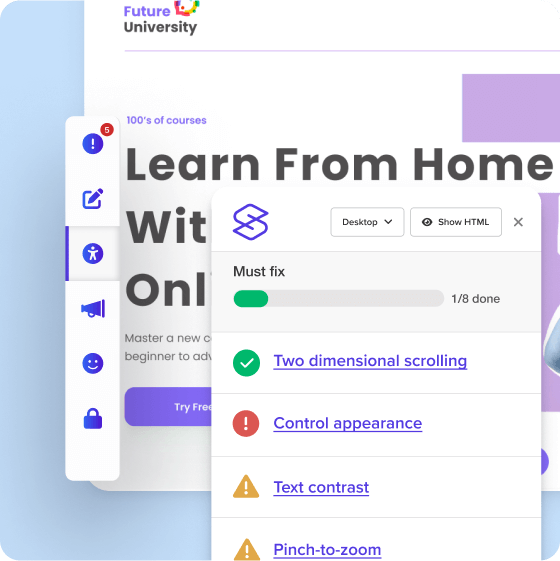What is the Accessible Canada Act (ACA)?
The Accessible Canada Act (ACA) sets out a framework to identify, remove, and prevent accessibility barriers across federal organizations and industries – including government departments, banks, telecommunications companies, and transportation providers.
The ACA establishes a nationwide approach to ensure that federally regulated organizations actively work to eliminate barriers that affect people with disabilities. Key components include:
Framework for accessibility
The Act requires organizations under federal jurisdiction to develop and implement accessibility plans. These plans must detail how barriers will be identified, removed, and prevented.
Institutional roles
- A Chief Accessibility Officer is designated to lead accessibility initiatives within federal organizations.
- The Canadian Accessibility Standards Development Organization (CASDO)—now operating as Accessibility Standards Canada—is tasked with developing and reviewing accessibility standards across various sectors.
Enforcement mechanism
An Accessibility Commissioner is appointed with the authority to investigate complaints, enforce compliance, and take corrective actions against non-compliant organizations.
Official resources:
Read the full text of the Accessible Canada Act on the Justice Canada website.
Who does the Accessible Canada Act apply to?
The ACA is designed to cover a broad range of organizations and industries that fall under federal jurisdiction. In practice, this means:
Federal public sector
All federal government departments, agencies, and organizations are required to comply.
Crown corporations
Entities owned by the state but operating administratively as private businesses must also adhere to the Act.
Federally regulated industries
Organizations that operate under federal regulation—such as banks, airlines, railways, telecommunications companies, mining companies, trucking firms, and broadcasters—are included.
Specific examples of organizations affected by the ACA
- Government bodies: Federal ministries, departments, and agencies.
- Transportation providers: Railways, airplanes, and inter-provincial bus services.
- Financial institutions: Banks and other financial organizations under federal oversight.
- Telecommunications and media: Companies involved in broadcasting, television, radio, and telecommunications services.
How does the Accessible Canada Act relate to web accessibility?
The ACA explicitly recognizes digital accessibility as a critical component of inclusion. Here’s how it applies to web accessibility:
Digital content & online services
Federal organizations must ensure that all digital content, including websites and web-based applications, is accessible to persons with various disabilities—whether visual, auditory, physical, or cognitive.
Standards for information and communication technologies (ICT)
- The Act directs CASDO to develop technical standards for ICT, which include guidelines for the design, development, and maintenance of accessible web content.
- CASDO has identified the Web Content Accessibility Guidelines (WCAG) 2.0 Level AA as the baseline technical standard. However, the ACA’s approach is flexible; future standards may incorporate additional or alternative requirements consistent with the Act’s accessibility objectives.
Minimum WCAG standards
While the legal minimum is based on WCAG 2.0 Level AA, many accessibility experts (including Silktide) recommend testing and designing websites to the latest standards – currently WCAG 2.2 – to ensure a more inclusive user experience.
Who enforces the Accessible Canada Act?
Enforcement of the ACA is a shared responsibility that includes:
Accessibility Commissioner
This office investigates complaints regarding inaccessible digital content and can take enforcement actions against non-compliant organizations.
Collaborative oversight:
The Act’s enforcement is further supported by agencies such as the Canadian Human Rights Commission and the Council of Federal Accessibility Agencies, ensuring that accessibility is upheld across all federally regulated sectors.
For more detailed information on enforcement and the roles of these bodies, you can refer to discussions in relevant government releases and legal analyses.
Does the Accessible Canada Act mandate a specific WCAG level?
Technical benchmark
CASDO has pointed to WCAG 2.0 Level AA as the foundational standard for web accessibility in Canada.
Evolving Standards
- The ACA does not strictly mandate WCAG 2.0 Level AA; instead, it requires that accessibility standards be developed in line with internationally recognized guidelines. This means that while WCAG 2.0 Level AA is the current benchmark, future revisions may include additional requirements.
- For those wanting to ensure best practice, industry experts advise testing against the most recent standards (e.g., WCAG 2.2) to maintain high levels of accessibility compliance.
How does Silktide help me comply with the Accessible Canada Act?
Silktide’s automated web accessibility testing platform is designed to help organizations comply with the ACA by:
Automated accessibility scanning
- Checking thousands of pages across your website to identify accessibility issues in the code, design, and content.
- Continuous monitoring to catch issues as your website evolves.
Actionable reporting
- Providing clear explanations and step-by-step instructions on how to fix identified issues.
- Offering ongoing reports and dashboards that help your team track progress over time.
Training & support
Supplementing automated scans with accessibility training programs for your content and development teams to prevent future accessibility problems.
Manual auditing and recommendations
While automated tools handle many tasks, Silktide also recommends manual accessibility testing for nuanced issues—such as ensuring alt text for images accurately describes content—which is often too detailed for automated solutions alone.
Silktide helps ensure your digital content not only meets the minimum legal requirements of the ACA but also provides an inclusive experience for all users.
In summary
The Accessible Canada Act is a groundbreaking piece of legislation that sets the stage for a more inclusive digital landscape in Canada. By establishing roles like the Chief Accessibility Officer, Accessibility Commissioner, and leveraging the expertise of Accessibility Standards Canada, the ACA creates a robust framework for ensuring digital accessibility across federally regulated organizations.
For those looking to dive deeper, consult the official Accessible Canada Act text and use tools like Silktide’s accessibility platform to keep your website compliant and user-friendly.
This page is intended to provide a detailed and accessible overview of the Accessible Canada Act, including links to the official legislative texts. For specific legal advice or tailored compliance strategies, please consult an accessibility law expert.
Check your accessibility now with our free browser extension

